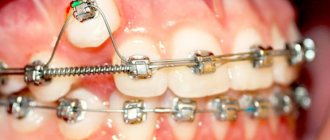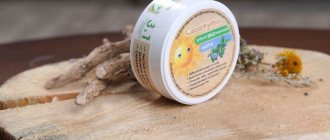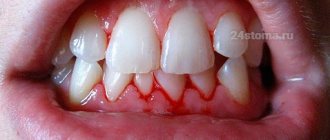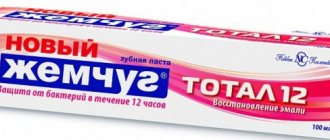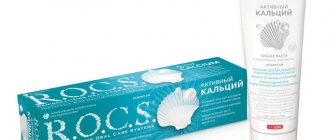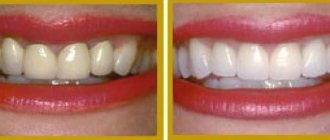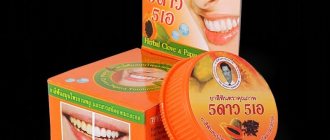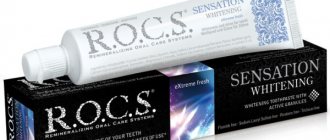Oral hygiene is important!
And the first thing that daily oral hygiene is associated with today is brushing your teeth.
and, of course, toothpaste. Although quite recently our grandmothers used dental cleaning powder. With the advent of toothpaste, the powder was forgotten. And now supporters of the powder method of brushing teeth are again appearing.
And here is the dilemma: what is healthier, tooth powder or toothpaste
?
The debate between supporters of one and the other method has been going on for a long time. Everyone defends their opinion.
From TV we hear every day about effective toothpastes, but almost no advertising for tooth powder. And this does not mean that the powder is ineffective.
Tooth powder or toothpaste - the choice is yours. But be sure to consult your dentist.
Purpose
It should be noted that at that time the purpose of tooth powder was not to prevent caries or treat periodontitis. At that time they did not even know such words, did not understand the reasons for their occurrence, and therefore could not yet contain these diseases with hygienic means. The main and only goal was to cleanse the teeth of plaque and tartar. Please note: in the first half of the 20th century, dentists had not yet performed such a now widespread procedure as professional oral hygiene. Neither ultrasonic nor air-abrasive (Air-Flow) treatment had yet been invented. The only way to remove conspicuous plaque is to clean it yourself.
Cleaning teeth with powder
For high-quality teeth whitening, the product under discussion must be used with a certain regularity, and to ensure that the enamel is not damaged when using a hygienic product, certain rules must be followed. The most important thing is a consultation with a dentist. Only a specialist can determine the advisability of using a particular hygiene product. If your doctor allows you to brush your teeth with powder, then you should use the product as follows:
- Distribute a little product onto the bristles of a toothbrush: electric or mechanical - it doesn’t matter.
- Brush your teeth, trying to treat the entire oral cavity and tongue. The more serious and thoughtful the cleaning is, the better the enamel will whiten. The procedure time should not exceed 3 minutes.
- When all teeth have been thoroughly brushed, rinse your mouth with mouthwash. Special products are sold in pharmacies and stores.
By following simple recommendations, you will soon notice that your teeth have become much whiter. The main thing is not to overdo it, otherwise instead of a beautiful smile you may end up with problems with the enamel.
Starting line-up
Therefore, a good century-old tooth powder is one that has excellent abrasive properties. Hence they added to it: pumice, sand, ground bones, eggshells, mollusk shells, broken bricks and God knows what else. It must be said that toothpastes of those times were in no way behind powders in terms of abrasiveness. Moreover, to help a good cause, individual inventors added acids and alkalis of varying degrees of aggressiveness to them. Well, of course - after all, tartar softened by acid is easier to remove (alkali has not proven its worth in this regard). In general, the evolution of hygiene products has moved towards clearly expressed aggressiveness.
Popular brands
Blend-a-med PRO-EXPERT effectively removes plaque, freshens breath, protects against caries and tartar, and reduces tooth sensitivity. Contains polyphosphates and stabilized tin, which have a beneficial effect on the condition of teeth and gums: strengthens and gently whitens the enamel.
Reading: Tablets for plaque detection
The German paste Lacalut is recommended for adults and children, which prevents the deposition of tartar, strengthens gums, and freshens breath.
International offers Colgate paste with a different set of medicinal herbs, anti-inflammatory, whitening, enamel strengthening effect,
“Forest balm”, as well as rinses based on medicinal herbs, with aloe vera, for various purposes, depending on the composition of medicinal plant components, are recommended for oral care and the prevention of dental problems.
Popular among consumers:
- Aquafresh,
- Paradontax,
- New pearls
- Splat Professional Active (does not contain fluorine).
Harm
But in 1907, an outstanding article was published in The Dental Cosmos: Miller WD. Experiments and observations of the wasting of tooth tissue variously designated as erosion, abrasion, chemical abrasion, denudation, etc. It had about the same impact on dentists as Albert Einstein’s “On the Electrodynamics of Moving Bodies,” published two years earlier, had on physicists. Equipped with terrifying illustrations, it clearly demonstrated the monstrous abrasion of teeth (in vitro) with pastes and powders. Here's one example:
Packaging of mi&ko and Phytocosmetics tooth powders
Fitokosmetik LLC tooth powder is packaged in a box made of type 5 plastic (PP). Everything is neatly labeled. Even the lid. Everywhere there is a sign that it is acceptable to use for food purposes.
Marking on the lid of the jar from Phytocosmetics
mi&co tooth powder is sold in dark glass packaging. The cover is plastic. Inside there is a standard absorbent backing. I was hoping to find the correct marking on the bottom of the lid under the gasket to ensure a tight seal. But there's nothing there. The cover is not marked. The guys from the store @bezupakovki_sochi said that the container is returnable. But I live in another city and was hoping to recycle the packaging when I no longer need it or breaks. Now I understand that I will have to go to Sochi to return the jar to the manufacturer.
The mi&co powder cap is not marked
One can argue about which is more environmentally friendly – PP or glass. I would say that in modern conditions it is more environmentally friendly if you can recycle it in your city. Here, for example, you can pass glass, but you cannot pass the “plastic five.”
Still, I think that regular tooth powder packaging is more environmentally friendly since mi&co also uses plastic, but we have no way of knowing if this cap is even recyclable.
Also, the liner cap is inconvenient for me personally because I don't like dipping my wet toothbrush into the powder. I pour the dose I need into the lid. From there I collect the powder on a brush, blurring it a little along the way. After completing the procedure, I wash the lid and place it on top of the jar, which I first cover with foil.
This is how I use powder, but add more.
Quality improvement
Of course, not all dentists read this study. Consumers of the powder certainly had no idea about it. Therefore, it took decades before highly abrasive components began to be abandoned. Such useful indicators as RDA (relative dentin abrasivity) and REA (relative enamel abrasivity) were introduced. The lower they are, the less the teeth wear out. Today, manufacturers who respect their customers indicate digital RDA values on each tube. Less than 70 – low abrasiveness, 71-100 – moderate, 101-150 – high, 151-200 – very high. Here is the RDA table for some modern pastes:
| Toothpaste name | RDA | Toothpaste name | RDA |
| Toothbrush with plain water | 4 | Colgate Sensitive Max Strength | 83 |
| Regular baking soda | 7 | Aquafresh Sensitive | 91 |
| Weleda Salt Toothpaste | 15 | Sensodyne Cool Gel | 92 |
| Elmex Sensitive Plus | 30 | Rembrandt Plus | 94 |
| Sensodyne ProNamel | 34 | Sensodyne Fresh Impact | 94 |
| Arm & Hammer Dental Care | 35 | Sensodyne Original | 100 |
| Weleda Calendula Toothpaste | 45 | Sensodyne Extra Whitening | 104 |
| Weleda Ratanhia Toothpaste | 45 | Sensodyne Full Protection Whitening | 107 |
| Arm & Hammer Dental Care Sensitive | 48 | Aquafresh Whitening | 113 |
| Tom's of Maine Children Toothpaste | 57 | Lacalut White | 120 |
| Colgate Sensitive Enamel Protect | 63 | Colgate Total Whitening | 142 |
| ClinPro | 65 | Colgate Total Advanced Fresh | 160 |
| Colgate Regular | 68 | Colgate Tartar Control | 165 |
| Colgate Total | 70 | Colgate 2-in-1 Tartar Control/Whitening | 200 |
| Colgate Fresh Mint | 70 | President White Plus | 200 |
Rating of high-quality whitening tooth powders for 2022
This category includes products whose main task is to give a natural shade to teeth. The best manufacturers for this year, according to buyers, are:
- "Fitocosmetic";
- "Royal Maral";
- "MI&KO";
- "Avanta";
- "Nissei".
"Phyto Doctor" from
Purpose: removing plaque formed with tea, coffee or tobacco; strengthening teeth and gums, preventing the formation of tartar.
The whitening composition from the professional series is suitable for daily use. In a short time it makes teeth two shades whiter. Ingredients: natural lemon juice, sea salt, orange oil, mint extract.
The product has a powerful antibacterial effect, protects well against caries and various gum diseases, and at the same time freshens breath.
The product is available in pharmacies, hypermarkets, cosmetics and household chemical stores. It is packaged in a tube with protective foil on the neck and a rotating lid.
Note! For sensitive teeth, the company offers ready-made tooth powder based on Altai clay and herbs: nettle, sage, juniper from the “Folk Recipes” series. Features of paste-like consistency - 5 times better action. The average price for a product is 80 rubles.
“Phyto Doctor” from - the first two models, in the third picture there is tooth powder from the “Folk Recipes” series
Main characteristics:
| Type: | ready mix |
| Nominal volume: | 45 ml |
| Taste: | mint + citrus |
| Positive result: | after 2 weeks |
| Net weight: | 87 g |
| Container material: | polypropylene |
| Recommended cleaning time: | 2-3 minutes |
| Best before date: | 2 years |
| Color: | white |
| Manufacturer country: | Russia |
| By price: | 50 rubles |
tooth powder Phyto doctor Fitocosmetic
Advantages:
- inexpensive;
- quick results;
- natural product;
- safe;
- reduces tooth sensitivity;
- no foam when cleaning.
Flaws:
- not identified.
Article "8852140" from
Purpose: to improve the appearance of teeth and prevent caries.
This family product in a jar is intended for children and adults for regular use. The composition includes the following components: extracts of Altai endemics, probiotics, flavoring (green apple).
A natural remedy that helps maintain healthy teeth and gums. With regular use, it helps smokers, coffee and tea drinkers get rid of plaque and keep their breath fresh.
Main characteristics:
| Type: | dry powder |
| Size (centimeters): | 5,5/5,5/7 |
| Net weight: | 95 g |
| Age limit: | 10+ |
| Taste: | apple |
| Recommended cleaning time: | 2 minutes |
| Usage: | daily |
| Packing material: | glass |
| Color: | light green |
| Manufacturer country: | Russia |
| Price: | 550 rubles |
tooth powder with probiotics Royal Maral
Advantages:
- effective care;
- natural ingredients in the composition;
- harmless;
- Suitable for children and adults.
Flaws:
- Expensive.
"062021-20" from
Purpose: eliminating bacterial plaque in the mouth, strengthening tooth enamel.
A domestic product based on white clay with extracts of herbs growing in the country. The main bleaching component is lemon. Suitable for people with hypersensitive teeth. The product restores natural whiteness and relieves gum inflammation.
Manufacturer's recommendations! The “mask” method will help you achieve greater success in whitening enamel. To do this, the mixture is mixed with water until it becomes mushy and applied to the teeth (leave for 15 minutes).
Main characteristics:
| Type: | dry mixture |
| Taste: | citrus |
| Net weight: | 50 g |
| Time to cleanse: | 2-3 minutes |
| Color: | beige |
| Tara: | brown glass jar |
| Manufacturer country: | Russia |
| Average price: | 230 rubles |
tooth powder 062021-20 MI&KO
Advantages:
- functional;
- fine grinding;
- effective;
- package;
- affordable price.
Flaws:
- unpleasant sour-salty taste;
- not for regular use.
"Mint" from
Purpose: removal of dental plaque.
A mixture for teeth with mint flavor from a Russian company is intended for whitening enamel. Suitable for adults who smoke or like to drink coffee. The mixture resembles flour in consistency and copes well with minor tartar on the teeth. When used, the prepared mixture does not foam and cleanses the oral cavity well.
Note! The company produces dental products with various flavoring additives and purpose of the series: “Special”, “Family”, “Whitening”.
Main characteristics:
| Type: | dry tooth mixture |
| Taste: | mint |
| Batch number: | 1 |
| Nominal volume: | 140 cm sq. |
| Recommended cleaning time: | 1-2 minutes |
| Application: | daily |
| Package: | plastic jar |
| Powder color: | white |
| Manufacturer country: | Russia |
| Average cost: | 20 rubles |
Mint Avanta
Advantages:
- effectively removes plaque;
- inexpensive;
- refreshing.
Flaws:
- The product is aggressive to sensitive enamel.
"Smoka Pink" by
For whom: smokers.
A product with the mint + winter greens flavoring additive freshens breath and dissolves tartar. Suitable not only for smokers, but also for people with increased plaque formation. The loose mixture in a metal can in white and red does not damage tooth enamel and leaves a pleasant smell, but it is not recommended to use it every day.
Main characteristics:
| Type: | loose mixture |
| Taste: | herbal |
| Volume: | 155 grams |
| To whom: | adults |
| Recommended usage time: | 1-2 times a week |
| Container material: | metal |
| Color: | pink |
| Vendor code: | 11013 |
| A country: | Japan |
| Price: | 800 rubles |
Smoka PINK Nissey
Advantages:
- does not crumple;
- lasts a long time;
- keeps the mouth fresh and clean.
Flaws:
- price;
- not for daily use.
Modern composition
So, coarse abrasives were disqualified from the contents of tooth powder. But what is there now? Soda, as can be seen from the table, has minimal harmful qualities. It is harmless, but its effectiveness is low. It weakly cleans plaque and does not “take away” tartar at all. Its hardness on the Mohs scale is 2.5. That's why the main ingredient in today's tooth powders is chalk (calcium carbonate). Its hardness on the Mohs scale is 3. It cleans teeth relatively gently and is more effective than soda. The rest is fragrances, flavor enhancers, dyes, etc.
What does tooth powder consist of?
The first model of the powder consisted of large chalk particles. They injured the enamel, leading to scratches and damage. New versions of the product also contain chalk, but its particles are reduced. It contains a chemically precipitated substance that prevents the thinning of the enamel.
Each product contains additional components. The performance of the tool’s functions depends on them:
- herbal extracts (relieving inflammation, destroying bacteria, reducing swelling in the eyes and other soft tissues);
- abrasive elements (increasing the strength of enamel, strengthening teeth);
- bleaches;
- sea salt (whitens, enhances metabolic processes, eliminates swelling of the gums);
- clay (gently cleanses).
Note! Abrasive particles are smaller than in previous versions of the powder, so the new compositions are safe.
The final victory of toothpaste
Back in 1914, there were attempts to introduce fluoride into toothpaste. But only after large-scale research in the early 1950s, which proved the effectiveness of fluoride toothpastes, did active commercial production begin. The pioneer was Procter & Gamble with Crest toothpaste. Then the rest of the manufacturers picked up the baton. In addition to fluorides (to prevent caries), antiseptics and anti-inflammatory components (to fight gingivitis), and desensitizing substances (to reduce dental hyperesthesia) began to be added to the paste.
How to choose?
When choosing a toothpaste, pay attention to the addition to its name:
- Active – means that the product is recommended for periodontal disease,
- White – produces a whitening effect due to high abrasiveness and peroxide content (citric acid),
- Sensitive – designed to reduce excessive tooth sensitivity,
- Fito – contains medicinal herbs.
Then check: the integrity of the packaging (tube), the release date (expiration date - 3 years). Familiarize yourself with the composition of the components: fluoride concentration should not exceed 2%, abrasiveness should not exceed 100 according to the RDA standard.
Where in the world is it used?
In developed countries, tooth powder is not produced. The last known global leader in the hygiene industry, Arm & Hammer, ceased sales in 2000. In Russia, tooth powder is used by 23% of the population. A recent study was conducted in India in 2022: it was found that 31% of rural residents and 15% of urban respondents use tooth powder. A strong relationship has been found between the use of tooth powder and abrasion of tooth tissue, bleeding and gum recession. This is the “beauty” you get after consuming Indian tooth powder:
Recommendations for use
In order for the use of tooth powder to bring maximum benefits, you should follow some rules .
Storage
It is necessary, first of all, to ensure proper conditions for storing this product so that it retains its beneficial properties :
- Avoid exposure to direct sunlight;
- ensure an acceptable temperature in the room where the powder is stored: from 0 to 25°C;
- do not allow contact with water;
- ensure that the relative humidity does not exceed 70%.
General rules
The choice of a specific powder should be made using the advice of a dentist, who must take into account the individual characteristics of the patient - the condition of the soft tissues, the quality of the enamel, the presence of various problems or diseases in the oral cavity.
- Do not dip a wet brush directly into the product. You need to dilute a little product with water in a separate container and apply the resulting mixture onto a moistened brush.
- Use only a soft toothbrush to clean with powder . It can be distinguished by the “Soft” marking.
- Follow the recommendations for the duration of the procedure . The greatest cleaning effect is achieved in 3–5 minutes.
- In one procedure, you can do double brushing : first with full powder, and then with a soft and non-abrasive toothpaste.
- Use this product no more than once every three days.
- After the procedure, it is necessary to rinse the mouth very thoroughly to remove all remnants of the hygiene product, food particles and removed dental plaque.
How to brush your teeth correctly
Please note that despite the fact that most of the Indian tooth powder fan's own enamel has been erased, the black plaque has not been cleaned out everywhere. And this is on the front surface - you can imagine how much worse the situation is on the internal surfaces. This happens because brushing your teeth requires, first of all, not strength, but intelligence. Instead of violent movements, moderate but frequent movements are needed. Not horizontal, but vertical, sweeping. From the gum to the tooth: from bottom to top - on the lower jaw, from top to bottom - on the upper jaw. And, naturally, you need to brush your teeth not only on major holidays, but every day. Then the soft plaque will not yet have time to calcify and stick firmly to the enamel.
Streptococci
These include Streptococcus mutans, Streptococcus sanguis, Streptococcus mitis, etc. These are acid-forming bacteria, which are characterized by anaerobic fermentation. The main causative agent of caries is Str. Mutans. Its content in dental plaque is about 90% of the total number of microorganisms.
A direct relationship between Streptococcus mutans and enamel destruction has been proven. The more of these bacteria, the more intense the carious process develops. In addition, scientists have found that Str. mutans does not belong to the normal (natural) microflora of the oral cavity; the pathogen is transmitted from person to person through saliva.
Lactobacilli
During their life, bacteria produce lactic acid, but they themselves are resistant to it. The number of lactobacilli in dental plaque is small. However, the concentration of these microbes increases significantly with the formation of a carious cavity.
Features of use
For tooth powder, the instructions for use are a little more complicated than for toothpaste. The toothbrush should be moistened with water and the wet bristles should be dipped into a jar of powder. It is advisable to immediately collect a portion for the entire one-time cleaning. After all, when re-sampling, microorganisms will get into the powder. Bacteria, by the way, will still end up in the jar (unless you use disposable brushes), because they remain on the fibers from the previous cleaning. But in the 12 hours that have passed since the last hygiene procedure, most of the microbes have already died and do not pose any danger to the owner. The same cannot be said about other members of the family. Therefore, everyone should have a personal jar of tooth powder - otherwise there is a high risk of infecting close relatives. This is another inconvenience compared to toothpaste - the whole family can use a common tube.
Write a comment
Valeria
May 29, 2016 at 7:18 am
I never gave preference to tooth powders, probably because I didn’t know about their properties, and it’s not convenient to use them. Who would have thought that it could have a beneficial effect on sore gums? But despite the fact that the powder has many advantages, I will still use toothpaste. I can’t switch to powder, it doesn’t foam and is kind of cloying.
Lena
May 31, 2016 at 8:07 am
I’ve been using tooth powders instead of toothpastes for more than two years now and I’m happy with everything. Firstly, you don’t breathe “ice” like after these thermonuclear pastes, secondly, it whitens and cleanses your teeth perfectly (I’m a coffee lover, so this is very important), thirdly, the powders are much cheaper. The only negative is the stains on the sink. There are slightly more of them than when using paste. I really like the powders and will continue to use them.
Dmitriy
July 11, 2016 at 5:13 am
At home I always use tooth powder. I constantly remembered the lines: “...and a fluffy towel, and tooth powder...”. One day I decided to try it, first I read about the pros and cons - I found out that before, they mostly used it, but then they stopped because it spoils the enamel. It’s just that before it contained chalk, which is an abrasive substance, but since then its composition has changed significantly. The disadvantages that remain are not significant for me.
Karina
September 7, 2016 at 03:16 pm
I once decided to try brushing my teeth with tooth powder instead of toothpaste. I didn't like it, it felt terrible. It is not easy to use, has an unpleasant taste and does not foam. And I love it when your mouth feels very fresh after brushing your teeth. There was no such sensation with the powder. I know many people prefer powder to toothpaste, but it's definitely not for me.
Anna
March 21, 2022 at 11:03 pm
On the recommendation of the dentist, I alternate the use of paste and powder. I noticed that this really gives a better result than using just one thing. It took me a while to get used to the powder. After using toothpaste, it’s a little uncomfortable that the powder doesn’t foam, but it’s all a matter of time and habit. Now I enjoy using both the powder and the paste. I visit the dentist much less often.
Anna
March 29, 2022 at 10:38 pm
I remember tooth powder from childhood, I really liked it then. But with the advent of pastes, it faded into the background and was gradually stopped being used. A couple of years ago, I accidentally came across Mint powder at a pharmacy and bought it. I alternate it with toothpaste—paste for two days, powder for a day. An excellent effect and the dentist noticed that the gums are less inflamed and there is no bleeding as before.
Lisa
July 5, 2022 at 12:24 pm
I think now few people use powder to clean their teeth. This happened at least due to the fact that now there are better products, and they cost less and do not cause as much inconvenience as powder. It is very inconvenient to use the powder; over time, no one has come up with packaging that would solve a number of inconveniences. In addition, after using the powder, tooth sensitivity increases.
Reviews
Why then are there such a huge number of positive reviews about tooth powder on the Internet and among friends? It’s not surprising - there are also a lot of words of praise about homeopathy and osteopathy. Valerian, Actovegin, Linex and a hundred or two other ineffective drugs find no less devoted admirers. A person is such an amazing creature that, having convinced himself of the usefulness of a particular drug, he can actually achieve a positive effect, even if this drug is an absolute dummy. This is called the placebo effect. After persistent self-hypnosis, the transition to truly more effective therapeutic and prophylactic agents is often met with hostility. Plus, irreversible negative consequences do not occur immediately. They include, among other things, the absence of a positive impact (prevention of diseases), which few fans think about.
Composition of teeth cleaning powders
Each locality had its own recipe for tooth powder. Before people came to the idea that finely ground chalk could serve as its basis, the product was made from gypsum, corals and shells, animal horns or egg shells. And only later a chalk-based powder appeared, and various oils were used as a flavoring: anise, mint, cinnamon and clove flowers.
Later, with the development of the chemical industry, chalk began to be deposited chemically. As a result, it became even smaller. Then its composition was further enriched with magnesium carbonate, and the tooth powder stopped causing damage to the tooth coating. At the same time, it provided high-quality cleaning.
Modern tooth powder, the composition of which is much more complex than that of its ancestor, also has numerous additives that have preventive qualities. Chalk is not the main component. It can be replaced by white clay, and additional substances are, for example, volcanic tuff or sea minerals. Powders with this composition clean the teeth in a gentle manner and can act as an excellent prophylactic agent.
Natural product
In addition to the low cost and supposedly better cleansing effect, many people are attracted to tooth powder by its environmental friendliness. Sodium lauryl sulfate, methylparaben, cocamidopropyl betaine and other horrors in toothpastes cause pronounced protest and rejection among many citizens. It’s difficult to argue with anything here - if you are a staunch opponent of “chemistry”, perhaps tooth powder is your choice. Only then be consistent - if your teeth suddenly hurt, do not treat them. After all, all modern fillings, crowns, dentures, and implants are also made of artificial materials. The natural behavior would be to remove the tooth, as our ancestors did (including those who used tooth powder a hundred years ago).
Pros and cons of pasta
The paste product has the following positive aspects:
Pros:
- the presence of a large number of auxiliary components that largely eliminate inflammation, infection, plaque;
- the foam-like structure distributes the paste substance over the entire surface, ensuring cleansing in all departments;
- ease of use due to reliable sealed packaging;
- a large selection of products thanks to the medicinal component, which allows you to buy a paste for daily or course use.
Minuses:
- most products contain parabens, triclosan, sodium lauryl sulfate, which are harmful in any quantity;
- fewer abrasive particles, which does not always ensure plaque removal and stone prevention;
- quality products have great value.
Attention! The product is chosen together with the dentist. He will recommend it according to the condition of the teeth.
Reviews from doctors
Why then do dentists recommend tooth powder? Well, not all dentists, but only some. And these latter are a minority. Of this minority, one half has never read a single book on their specialty in their lives (yes, don’t doubt it – such copies exist). I read the second half, but these were reprints of Soviet textbooks from the 30s (and toothpaste was not produced in the USSR until 1950). And the third half, although familiar with modern concepts, understood little about them. If you ask such scholars the question: “What randomized controlled studies are you willing to refer to to confirm your recommendation?”, you may encounter the most unexpected response.
Popular means
As an example, here are several varieties of this product from well-known manufacturers.
Gum Gold / Gum Gold
This is an Ayurvedic remedy that contains many beneficial herbs and components.
Among them:
- mint,
- him,
- ginger,
- galanga,
- Red stone,
- mountain salt.
Regular use allows you to strengthen the gums and enamel, reduce bleeding of soft tissues, relieve inflammation and increase microcirculation of blood in the periodontal tissues, whiten and polish the enamel without causing harm.
Completely natural composition with no artificial additives.
The cost of a 60 g package is about 200–230 rubles.
For those who should use bamboo toothbrushes with charcoal coating, read our new review.
In the next publication we will talk about the features of oral sanitation during pregnancy.
At the link https://www.vash-dentist.ru/krasota-i-uxod/otbelivanie/kak-provoditsya-zubov-aktivirovannyim-uglem.html you can read the opinions of dentists on the use of activated carbon for whitening and leave your review.
Lion Tobacco
Created specifically for smokers to effectively protect against a specific unpleasant odor and heavy plaque. The whitening effect can be achieved within a few days.
Sold in packs of 160 grams, the cost is on average 350–370 rubles .
Sunny bunny
The main composition contains 14 herbs : mint, dandelion, sage, thyme, chamomile, oak, St. John's wort, calamus, nettle, alfalfa, birch, ginger, agrimony, coltsfoot.
Safe for children, helps fight inflammation in the gums, reduce bleeding and gently whiten.
The package contains 50 grams, its cost is about 330 - 340 rubles.
Mint
The base – calcium carbonate – is supplemented with menthol and natural mint oil .
Does not contain additional fragrances or harmful components.
The cost of packaging (140 g) is about 25–40 rubles.
Conspiracy of toothpaste manufacturers
But there are also completely unique opinions from dentists. One well-known Moscow orthodontist (a competent doctor, a supporter of evidence-based medicine) posted a publication on her own website: “How dangerous is tooth powder?” With 31 links to sources of information - to give due weight to your own words. The article contains a lot of reliable information, but the conclusions are paradoxical. From the thesis about the higher abrasiveness of certain toothpastes compared to some tooth powders, the author concludes that the superiority of toothpaste over tooth powder is a myth. Formed by advertising from greedy paste manufacturers. No analysis or explanation of why evil advertisers chose for promotion a powder that was not well-known to everyone at that time, but a new, unpromoted product (and, therefore, requiring greater campaign costs) is naturally not presented. This same characteristic mistake is also popular among patients. But you only have to think a little to realize that it is much easier to advertise a cheap, low-cost, and even much more popular product to increase its selling price - and the conspiracy theory will naturally dissolve.
Which is better: toothpaste or tooth powder?
It is difficult to say unequivocally which product is best to use for whitening - each has its own characteristics. It is best to make a choice based on your own priorities:
- if you need a product that is inexpensive and can whiten crowns quickly, tooth powder will be an ideal option;
- if you need a product that whitens teeth for a relatively long time, but gently and with a longer-lasting effect, it is better to choose a special paste. You should also choose a paste with chemical active ingredients if you want to lighten your teeth to a white shade: the abrasive can whiten teeth only to their natural color, which is not white at all, but beige - due to dentin showing through the enamel (in people with thin enamel, the natural color teeth may even be light yellow). Therefore, it is possible to give teeth whiteness in the literal sense of the word only through chemical action.
Which is safer?
Tooth powder still confuses some due to the presence of small particles that can be accidentally inhaled while brushing your teeth. Indeed, there is such a possibility. But only small children should be afraid of it. Curiosity may cause them to bring the container of powder closer to their nose, and then the risk of inhaling small particles will increase. Greenway powder is not prohibited for use by children, but the manufacturer recommends doing so only under adult supervision.
READ ALSO: Tips for choosing neutral equipment
Tooth powder is often accused of being unhygienic. They say that you need to dip a wet brush into it, which leads to the moistening of the granules and the proliferation of bacteria in the container with them. That's how it is. But it all depends on the composition of the product. If it contains components that kill harmful microorganisms, the risk is reduced to zero. In Greenway powder, sea salt plays the role of protection against bacteria.
